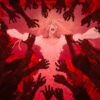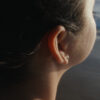Read all our coverage of the 2011 Toronto International Film Festival here.
There’s a scene in “Oslo, August 31st” that may be the finest crystallization of quarterlife restlessness I’ve ever seen. It occurs on the day Anders (Anders Danielsen Lie), a former junkie who squandered his twenties in and out of rehab centers, returns to his Norwegian hometown at the end of summer to visit friends and interview for a potential job at a magazine. As the editor who interviews him for the editorial assistant gig learns, Anders hardly fits the profile of a recovering addict, calm and obviously mature for his age until their talk goes south when Anders is pressed for details about where he’s been since writing his last articles a few years earlier. Once he storms out, he retreats to a nearby cafe to collect himself and it’s there where he sits centrally as life literally passes him by, overhearing the conversations of others and keeping an eye on the pedestrians outside. The scene is a marvel, achieving an overwhelming of the senses that could only be done in the medium of film, yet it’s also such an emotionally precise moment that it knocks you down when you least expect it.
Although Anders struggles to find his way, the film’s director Joachim Trier has had no trouble carving out a name for himself, triumphantly transitioning from a teen skateboarding champion in Norway to a world-class filmmaker whose virtuosity has been confirmed in just two films, 2005’s “Reprise” and now with “Oslo,” which he made with much of the same team as an experiment in a speedier, looser production.
As Trier told the audience before the film’s premiere at the Toronto Film Festival, whereas “Reprise” took four years to fine-tune, “Oslo” took just four months, though the quicker turnaround hasn’t shortchanged the depth of his work. With the vibrant and heartbreaking story of Anders, Trier proves he isn’t just one of the finest filmmakers of his generation, but one its keenest observers and while he was at the festival, he graciously took the time to discuss the making of his latest film, how he accomplished that incredible scene in the cafe, the importance of close-ups and his own favorite film he’s seen in Toronto.
How did this come about?
It’s kind of a strange story. It had been a while since “Reprise” and I suddenly got this urge like what if we make a film quick? We knew we had this old French novel “Le feu follet (The Fire Within)” that we really liked and we thought okay, let’s try to do a film quickly and see how that affects our aesthetic. Eskil [Vogt] and I had written three films together…or had written two and [now are] going into the third, and I felt I was ready to try to do something that had more spontaneity to it. So a year after, we had a movie.
We based it on this novel that we obtained the rights for, the source material from 1931, but it’s such a simple story of just an ex-addict coming out of rehab and spending a day asking himself fundamental existentialist questions. I thought if we put that in Norway, the Norwegian environment we know today, it could maybe illuminate the lives around us. So it’s more that the concept interested us and then we could draw on the city we knew, Oslo, and we could draw on characters that we knew in some way or another.
I have to admit, I haven’t read the novel, but…
Almost no one has. [laughs]
But it was adapted before I know…
By Louis Malle, yes.
The part that really spoke to me was not necessarily the story of addiction, but that this was a person that was leaving his twenties behind, which had to mean something different in the era it was published than it does today.
Exactly. It’s not a study of addiction in itself. It’s more here’s your life. He’s a privileged guy, he’s got choices in life and he feels that he hasn’t taken his opportunities. Then suddenly he’s standing there in his early thirties, looking around at all the people around him that have created lives, families, jobs, and where does he go from there? I thought that was a kind of loneliness, a solitude that I wanted to convey because I’ve seen people end up there. I’ve often wondered [why] such wonderful people, for no obvious reasons, have a self-destructiveness to them or an inability to cope with the normal things in life.
Having grown up in Oslo yourself, was there an aspect of life imitating art in this story of man returning to his roots?
I live there now for the moment and I think it’s a city that time and again surprises me with its beauty. The beauty is Oslo is hidden and you have to go search for it. And with this film, we convey the melancholy of fall in that city. It’s a mood that I think is quite particular – the Nordic lights at the end of August — and I just think it’s really interesting.
One of my favorite lines from the movie is during the opening voiceover from one of several characters who says their father told them that “melancholy is such a cooler word than nostalgia.” Do you actually think there’s a danger in nostalgia?
Yeah, I think so. I feel very strongly that melancholia is a mood and almost a philosophical state of dealing with the fact that things are in passing and withering and it’s an essential emotion to the human condition. The danger could be to be someone in a nostalgic sense that ponders on, “Oh things were so much better before” or doing like a cute portrait of Oslo, like “Oh, all these places are going to wither” and play the [sad] violin. No! Humans are in movement forward and we leave things behind. And it may be the tragedy of Anders is his inability to reach out and welcome the new, so there’s a danger to nostalgia surely.
If you could talk about one scene that was so staggering to me, how did you conceive and execute the scene in the café where Anders simply sits there, overhearing the conversations of everyone around him while contemplating his own life.
It’s an exploration, really and a part of working quick was we wanted to use the advantage of leaving some open doors, letting certain things not be decided. One of those things was in that scene — some of it was written, some of it is documentary. We shot a café over two days. One day was a planned day where we let people on the outside walking past that he looks at be documentary, but everything inside on the planned day was planned by us. We had control over the extras. Then we shot the next day where we just let people come in and they had to sign a release form, “If you’re in the café today, you will be filmed.” We waited and we stole little moments from people and I thought for this kind of story, doing this snapshot of Oslo in one day, that was interesting to me.
For example, while we were writing, I was listening to a radio program. There’s a young girl talking about something that’s a big thing on the Internet now, which are these blogs, “50 Things to Do Before You Die” that people all over the world are doing. [laughs] Supposedly, the thing they all share in common is that everyone wants to swim with dolphins, so that’s one of those things we just wanted in there. I thought how would that be for this bleak, existentially stern man to sit and listen to this girl with her naivete…interesting. So let’s find the girl. We found the girl that was on the radio program and got her blog and that’s the blog in the film. We tried to just bring things in from reality and see how it would play in the story and we felt as long as it had a thematic resonance or connection, we would keep it. Lucky accidents happen. A character that was cast in the film in one scene walked past by random outside the café when we were filming and we got him on film. Strange things happen.
That sounds like something one of the opportunities I’ve heard you discuss before about setting the film in the 24-hour time frame. How did that open things up for you?
I’m used to maybe overthinking or spending a long time rewriting and rewriting, trying to perfect things and I think there’s something liberating in being forced to know okay, you’re going to shoot a film at that point in time. You do what you can at that point and keep some doors open. The great director [Jean] Renoir said that he “always keeps a door open on set in case a friend visits.” Something could happen. So it actually liberated me to trust my instincts more. I believe instinct is not something you’re born with — it’s a long, long process of training. I’ve actually made films since I was a kid. I made short films, videos, all kinds of weird things and it was liberating to go for the first idea [I had] and not always question why that idea came about, but trust that it would fit into the whole.
It would seem like one of the big challenges of this film would be figuring out the logistics of making some of the longer conversations in the film as interesting visually as they are to listen to.
I was interested in this film being very extreme in various directions. There are long pieces of silence with no dialogue in it. Then there’s a lot of talk. For example, Anders has a very heartbreaking conversation with his good friend Thomas, where they try to communicate, but it’s very hard for them – I wanted for once in cinema to spend 20 minutes on a conversation like that. Just let’s go all the way. This is my one chance in life to [film] a conversation like that. I’ve had those conversations. I know how it is to help someone who’s in trouble and the strange, weird humor that arises sometimes. Let’s just study that, let’s really spend time on it and hopefully, it will come out truthfully.
Then again, as you ask, how do you do that visually? Some of it is about also trying to do interesting close-ups. People always say close-ups, that’s television. No. There is a tremendous difference between a close-up on TV and a close-up in cinema. A close-up in cinema, you get close to a face in a way you don’t ever in reality. It’s ridiculous how close you can get with a camera in the cinema, really looking at people and their emotions and what they go through. So I think particularly for that scene, it’s how I use close-up. Sometimes I’m far away, sometimes I’m extremely close and the dynamic of that is how I approached it to try to make that work musically for the dialogue.
On that note, I wanted to ask about the literal music for the film – a lot of American bands are featured on the soundtrack. How did you decide what music to have in the film?
Like with my previous film “Reprise,” music is incredibly important, both on an emotional level for the film, but also to fit the story of the character and where he comes from. In this film, we have a huge range. We have the old Norwegian band A-Ha and we have a lot of new Portland music. We have Desire and Glass Candy, who are great underground Portland electro scene bands. We have Daft Punk, and there’s a lot of classical music. I haven’t worked with that so much before, so that was interesting. And the Norwegian artist Torgny has made a lot of music and I’m glad that he became a part of the project as well. I save music for this one. I don’t use it all the time. I save it for the end and to use it specifically.
Have you actually been able to see anything in Toronto while you’ve been here?
Yes, I saw “The Descendants” yesterday, which I enjoyed. I know Alexander Payne, he invited me and it was a great honor. A really nice, cool film and I think there’s some moments in there that are really cinematically unique.
“Oslo, August 31st” currently does not have U.S. distribution. (Which needs to change immediately.) It will play Toronto once more on September 18th at AMC 3.



